Archive for June, 2024
[WEB] UNLOCKING NEW POSSIBILITIES: THE THIRD THUMB’S ROLE IN MODERN PROFESSIONAL AND PERSONAL TASKS
Posted by Kostas Pantremenos in Assistive Technology, Paretic Hand on June 16, 2024
The Third Thumb is an extraordinary prosthetic innovation developed by Dani Clode and her team at University College London. Unlike traditional prosthetics that replace a lost limb, this device adds an extra thumb to the hand, significantly enhancing the human body’s capabilities. This 3D-printed, wearable thumb attaches opposite the biological thumb and is controlled by a unique system involving pressure sensors under the toes. These sensors communicate wirelessly with the thumb through a device worn around the ankles, allowing users to manipulate the thumb by applying pressure with their toes.
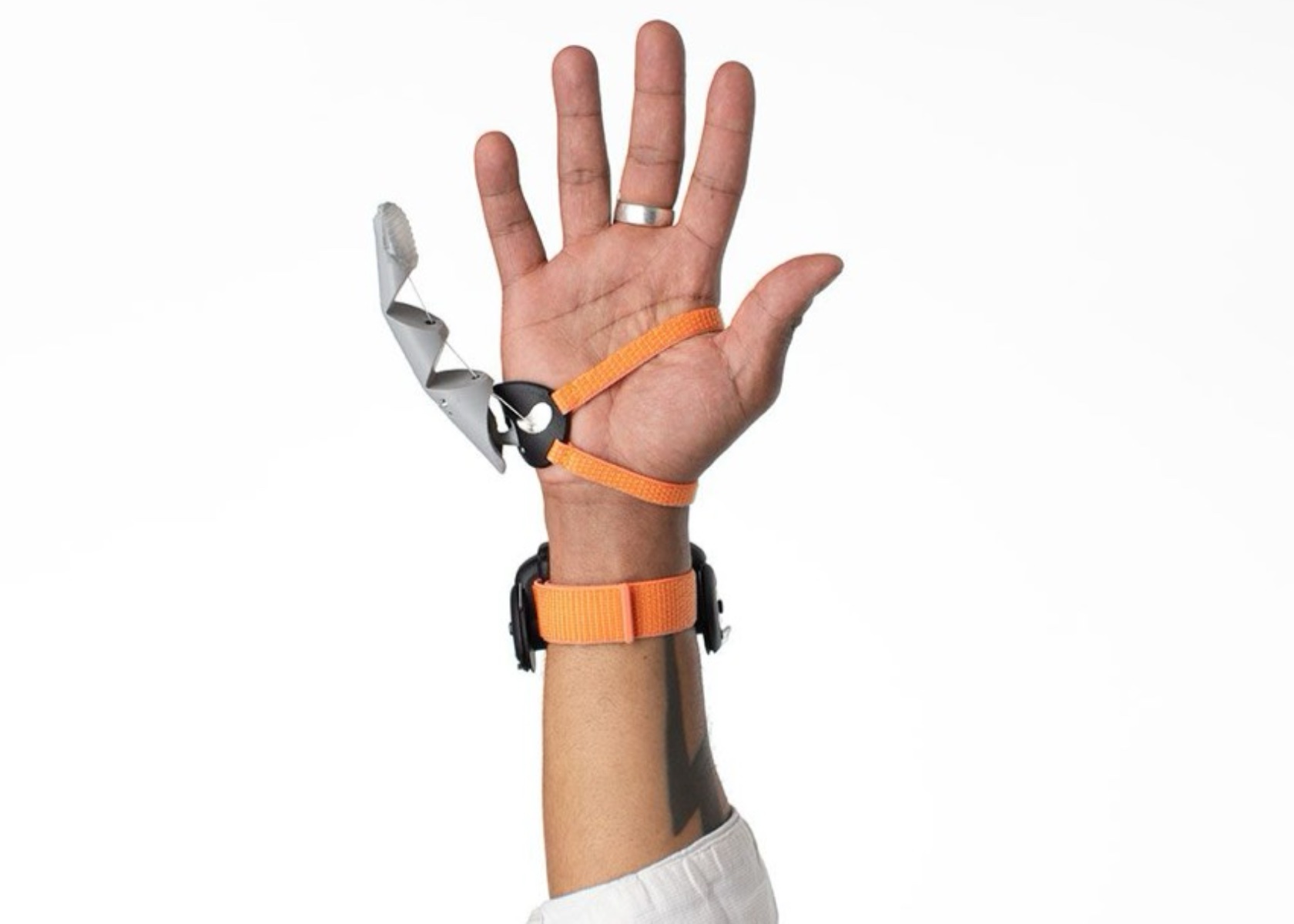
Designer: Dani ClodeDani Clode
The potential uses for the Third Thumb span a range of everyday and specialized tasks. For instance, consider a busy parent juggling grocery bags, a phone, and keys. An extra thumb can make it easier to carry more items at once, reducing the number of trips back and forth to the car. It can hold a phone steady for video calls or scrolling through social media, freeing up the other hand for additional tasks. Cooking also becomes more manageable, as the extra thumb can hold food in place while cutting, providing better stability and precision.
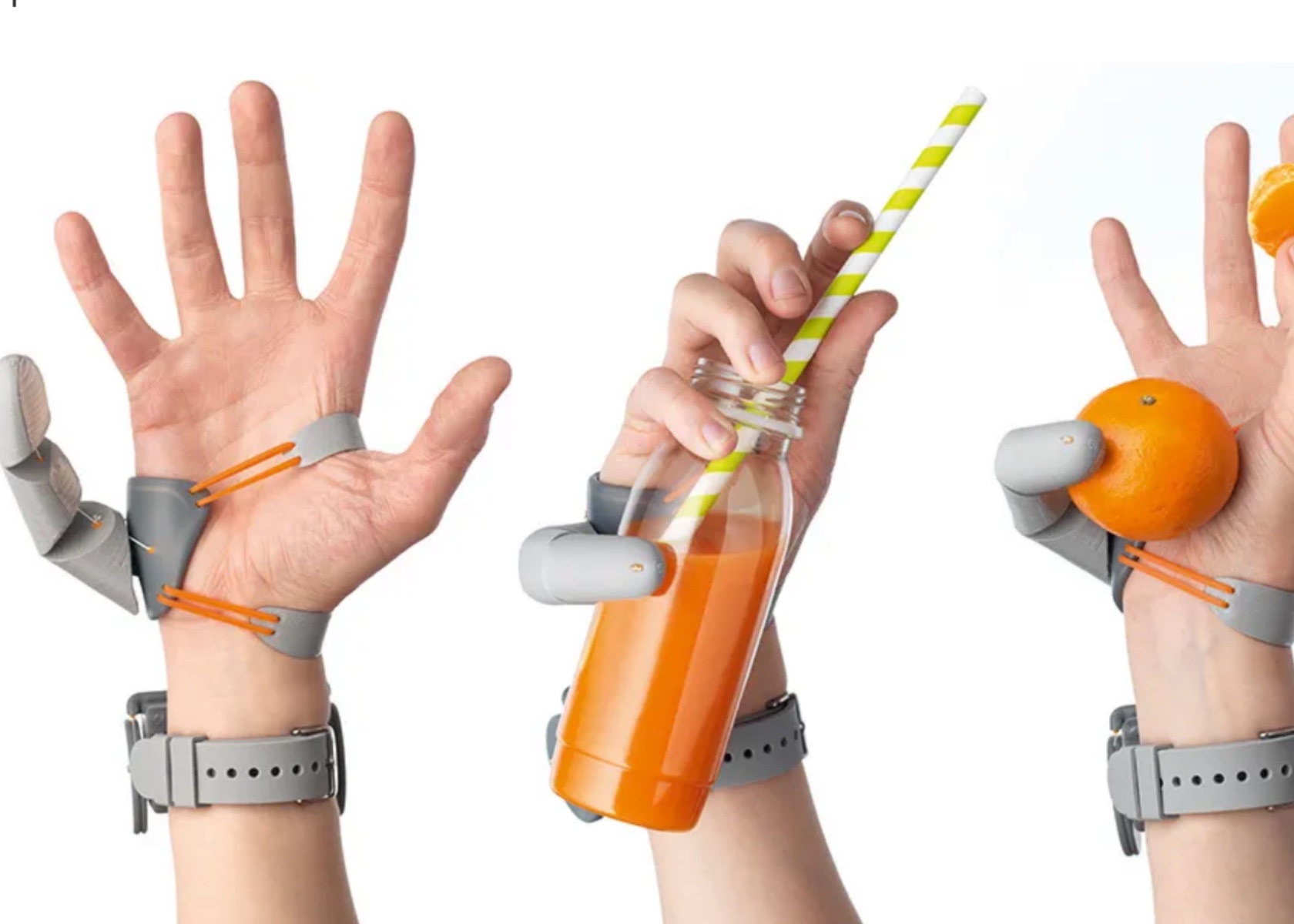
In professional settings, the Third Thumb shows even more promise. Musicians, for example, can use the thumb to unlock new playing techniques and enhance their performance. Guitarists can reach additional notes and chords previously out of reach, while pianists might find new ways to tackle complex pieces. Drummers could use the thumb to hold additional drumsticks or percussion instruments, allowing for more dynamic and intricate rhythms.
Manual laborers and artisans can benefit from the Third Thumb’s ability to hold tools and materials. Imagine an electrician who needs to keep a wire in place while using both hands to operate tools. The extra thumb can securely grip the wire, making the task more efficient and safer. Carpenters and woodworkers can hold pieces of wood or nails in place, freeing up their hands to use saws, hammers, or drills with greater control and precision.
Surgeons and medical professionals are another group that could see significant advantages from using the Third Thumb. In surgeries requiring high dexterity and precision, an extra thumb can hold instruments or tissues, allowing the surgeon to perform delicate procedures with greater ease and stability. This could potentially reduce the time needed for certain operations and improve patient outcomes.
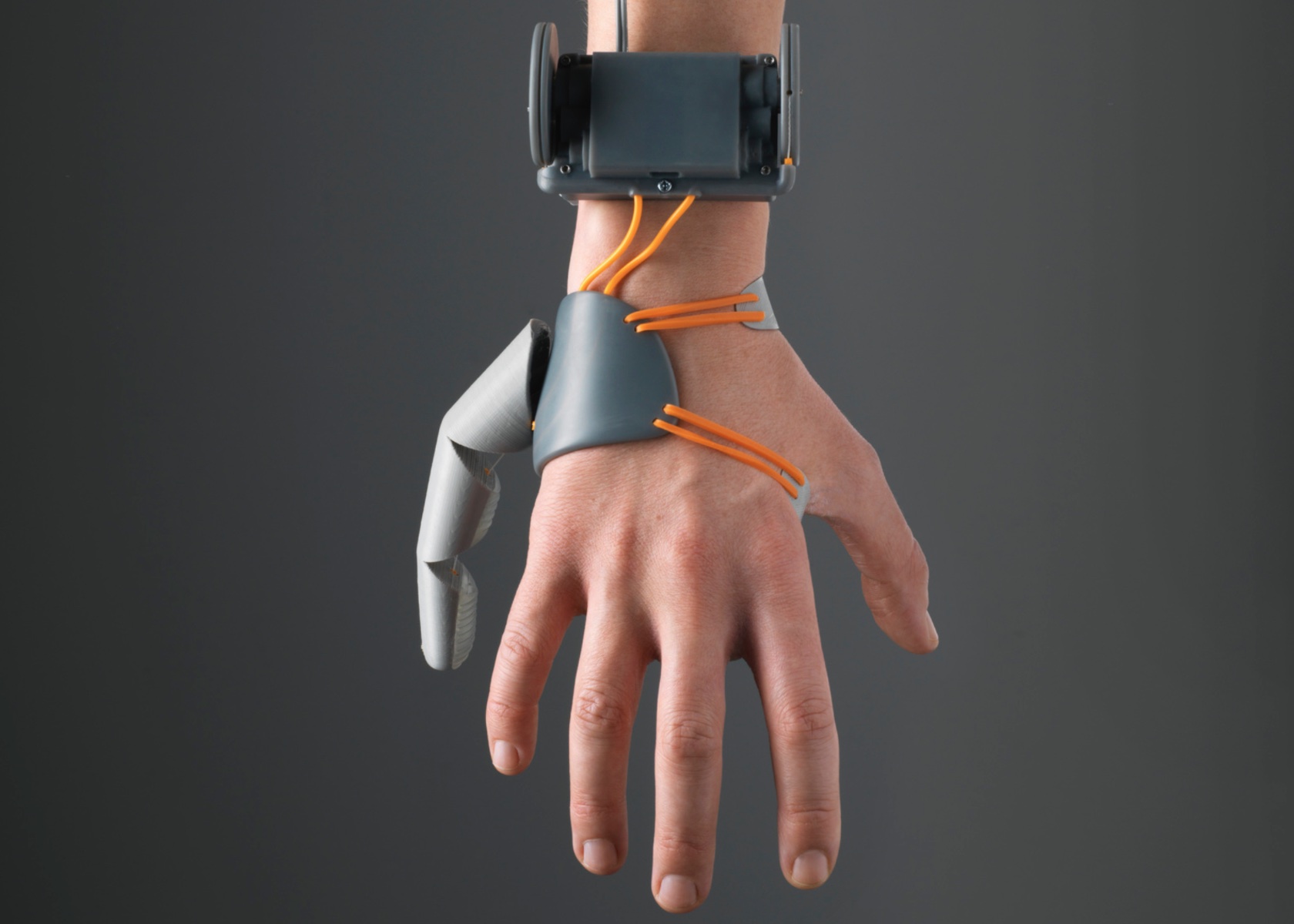
The device’s versatility extends beyond these specialized fields. Bartenders, for instance, can use the extra thumb to hold bottles and glasses, making it easier to prepare complex cocktails during busy shifts. Chefs benefit from the additional grip when handling multiple ingredients or plating dishes with intricate presentations. Even office workers find value in the Third Thumb, using it to hold a phone or notepad while typing or taking notes during meetings.
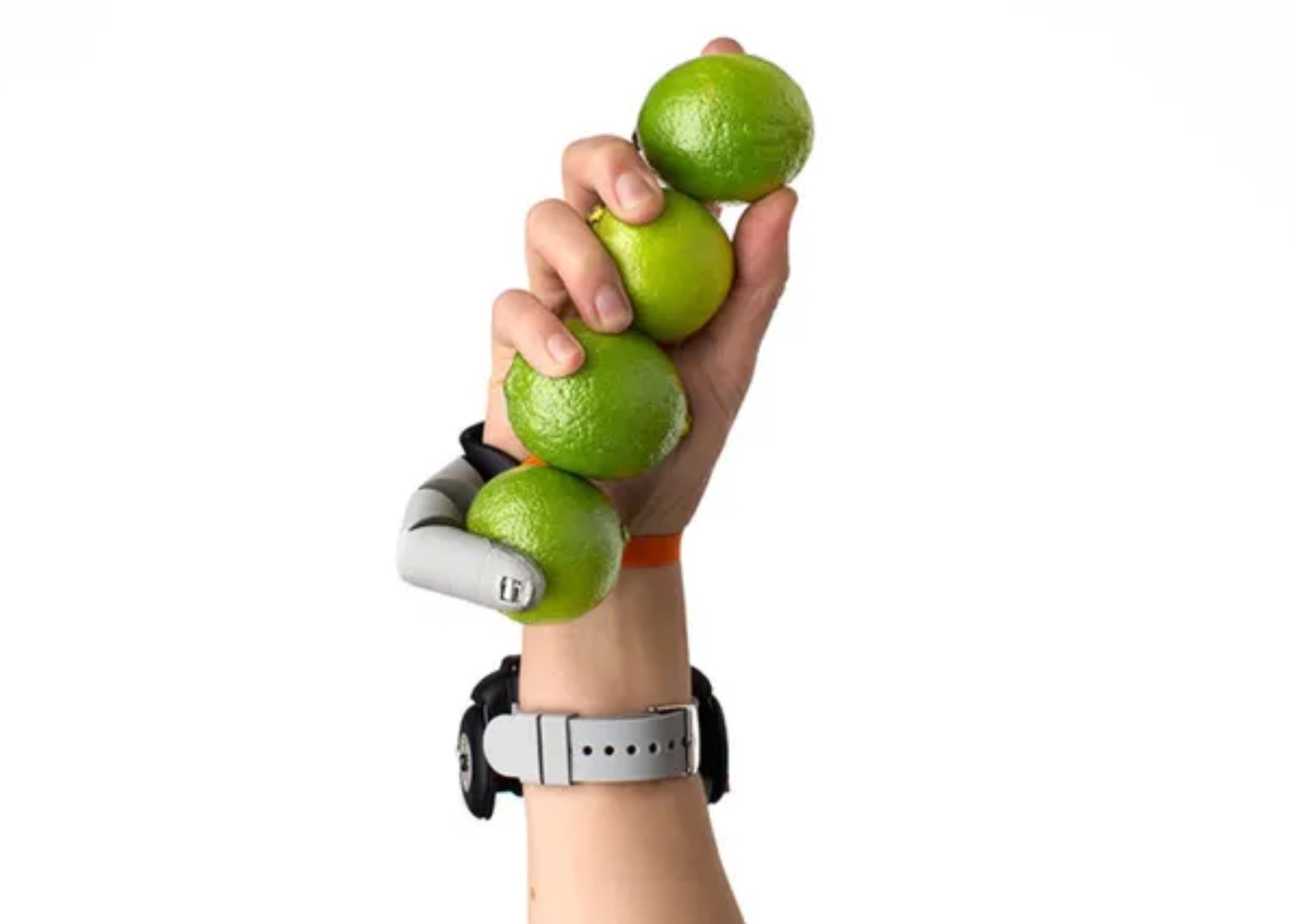
Students and teachers can leverage the Third Thumb to manage multiple tasks simultaneously in educational settings. Students can hold textbooks or tablets while taking notes, enhancing their ability to study and learn. Teachers can use the extra thumb to hold teaching materials, allowing them to interact with students more effectively and manage classroom activities with greater ease.
Despite its many potential benefits, the necessity of the Third Thumb for the general public remains a point of discussion. For most people, the traditional two-thumb setup has proven sufficient for daily tasks and activities. However, the device’s ability to enhance efficiency and multitasking could appeal to a broad audience, especially those who frequently manage multiple items or tasks simultaneously.
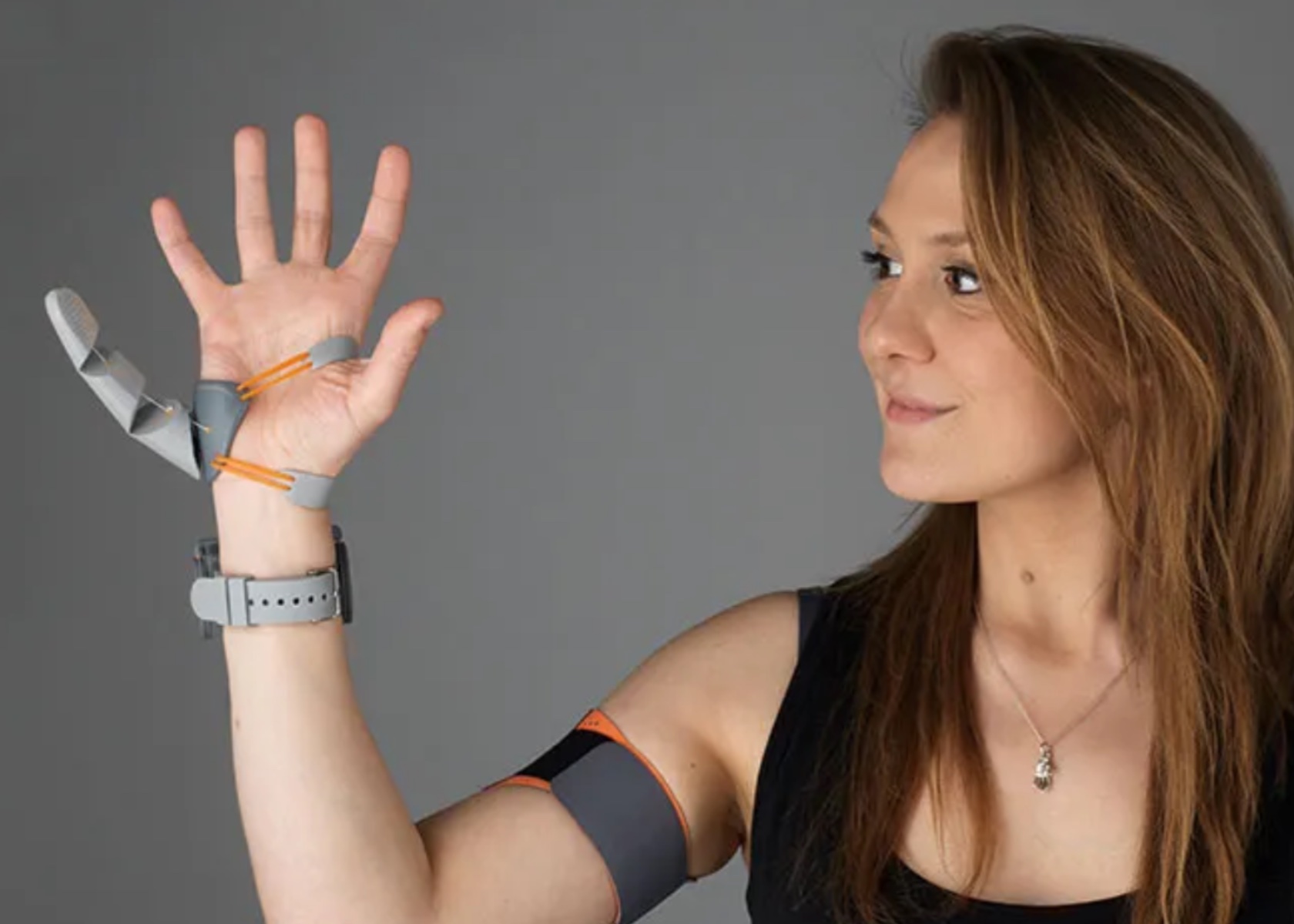
The ease of use and adaptability of the Third Thumb are key factors in its potential adoption. During trials, including demonstrations at the Royal Society Summer Science Exhibition, participants quickly adapted to the device with minimal training. Remarkably, 98 percent of participants could use the thumb immediately, demonstrating its intuitive design. The control mechanism involves pressure sensors under the toes, which communicate wirelessly with the thumb through a device worn around the ankles. Pressure from the right toe moves the thumb across the hand, while pressure from the left toe moves it toward the fingers. This intuitive setup allowed users to quickly understand and manipulate the extra thumb, making it suitable for seamless integration into daily routines.
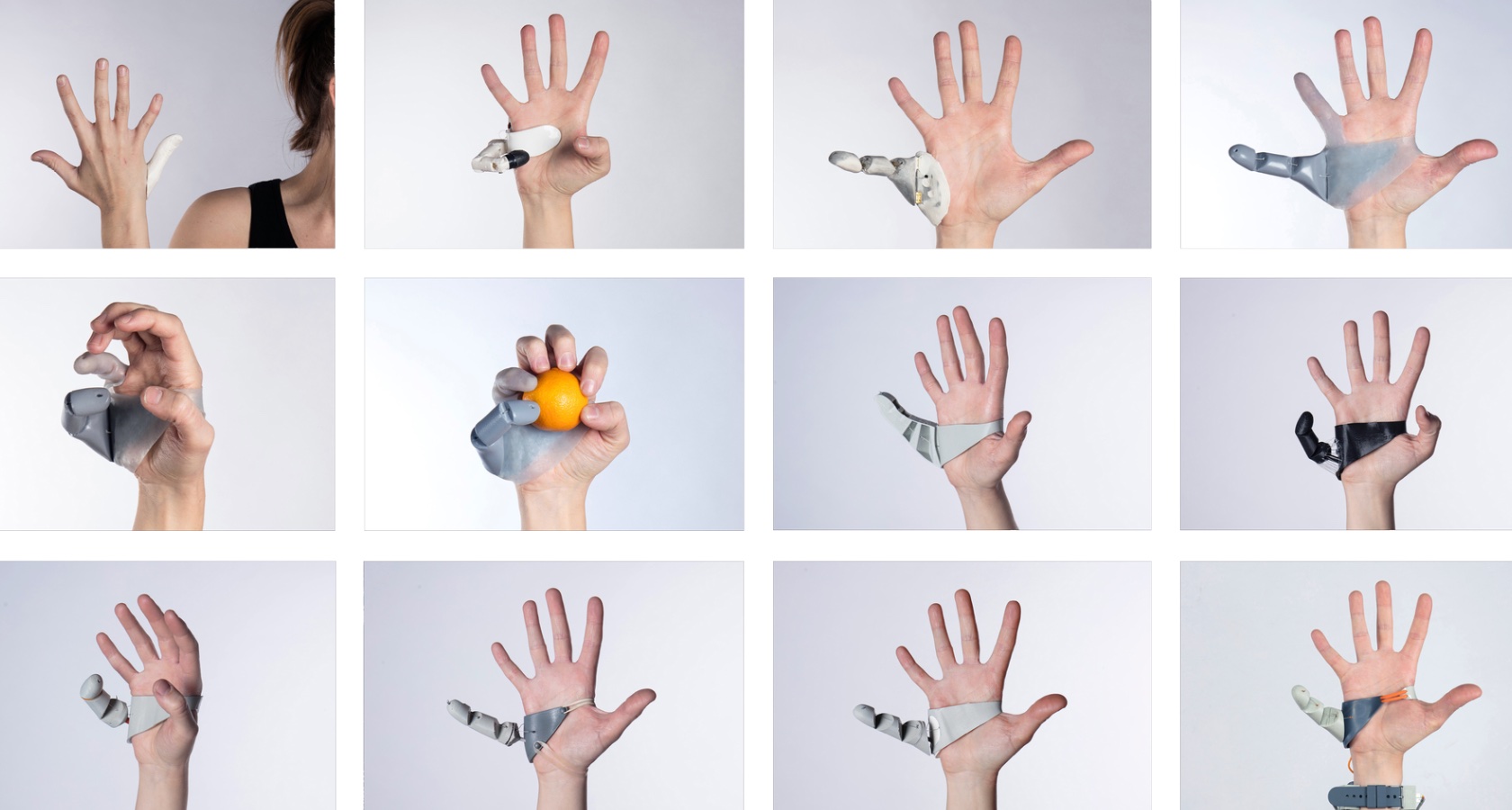
As with any new technology, bringing the Third Thumb to a larger audience will be challenging. Manufacturing, marketing, and distribution will be crucial in determining its success. Additionally, the device’s affordability and accessibility will be important considerations for widespread adoption.
[WEB] 5 Essentials Epilepsy Caregivers Should Know
Posted by Kostas Pantremenos in Caregivers, Epilepsy on June 13, 2024

If you’re good at thinking on your feet and staying calm during an emergency, you probably have what it takes to care for someone with epilepsy. Although individuals with epilepsy all have unique needs, there are some basics that every caregiver ought to know, like medication side effects and how to provide seizure first aid. Here’s a quick list to keep in mind, along with an important reminder to collaborate with the neurology health care provider on treatment options and care decisions.
Remember, you don’t have to be perfect to be a good caregiver. You just have to be willing to learn and provide the level of support needed. Here’s how.
1. Learn How To Describe a Seizure
There are several different types of seizures, and the symptoms of each may vary. When caring for someone with epilepsy, you’ll need to see and understand what’s going on to respond appropriately and report back to the doctor with an accurate description of what happened.
According to the International League Against Epilepsy, there are three primary types of seizures. Focal-onset seizures start in a distinct area of the brain. However, generalized-onset seizures affect both sides of the brain at the same time. A third type, unknown onset, happens when someone is alone or asleep and wasn’t witnessed by another person.
All types of seizures can cause motor symptoms or nonmotor symptoms. Examples of motor symptoms in focal-onset seizures include:
- Fast muscle twitching
- Jerking movements
- Limp or weak muscles
- Tense and rigid muscles
During a focal-onset seizure, the person may also perform repetitive motions like rubbing their hands together, clapping, chewing, or lip smacking. Limp or tense muscles and muscle twitching can also happen in generalized-onset seizures. In addition, sustained rhythmic jerking or epileptic spasms (where the body extends and flexes repeatedly) can happen.
Some seizures involve nonmotor symptoms, which aren’t always as readily noticeable. In a focal-onset seizure, the nonmotor symptoms may include feeling hot or cold, cognitive changes, sudden emotions, goose bumps, or a lack of movement, known as behavior arrest. Nonmotor symptoms in a generalized-onset seizure can involve staring spells, brief eyelid twitching, or twitching of another body part.
Caregivers play an essential role in observing seizures. Although you don’t need to know all the terminology or be a seizure expert, you should understand what to watch for and expect.
2. Understand How To React During a Seizure
In addition to keeping track of the seizure signs and symptoms, you’ll need to ensure the person you’re caring for is safe during a seizure. An epilepsy and seizure training program will allow you to practice and see demonstrations of what to do during a seizure. You can call your local hospital to see if any programs are available.
During a seizure, remain calm and gently place the person on their side for better breathing. Check for anything tight around the neck, remove their eyeglasses, and put something soft and flat under the person’s head. Don’t hold someone down or try to restrain them during a seizure. Instead, take away anything nearby that’s hard or sharp to clear the space and reduce the risk of injury.

It’s a common myth that someone can swallow their tongue during a seizure — that’s not true. Never put anything in someone’s mouth or offer them something to eat or drink until they’re fully conscious and alert.
3. Be Aware of When To Call the Doctor
People with epilepsy who have a history of seizures probably don’t need medical attention just because of a seizure alone. Although you’ll want to inform their doctor that a seizure occurred, you don’t need to call 911 unless the following conditions occur:
- The seizure lasts longer than five minutes (start a stopwatch as soon as the seizure begins, if possible).
- A second seizure occurs shortly after the first one ends.
- An injury happens during the seizure.
- The person is in water during the seizure.
- After the seizure, the person has trouble walking or breathing.
- The individual has additional health conditions, like diabetes, pregnancy, or heart disease.

Ask the neurologist about any other reasons you should seek emergency care. When in doubt, you can always call to speak with a health care professional and determine if more follow-up is needed.
4. Figure Out When To Tag Along
Seizures can happen unexpectedly. If you don’t live with the person you’re caring for, you’ll need to coordinate your schedules to make sure you can be around for high-risk situations. Examples include leisure activities in or near the water, like a trip to the beach or pool. It’s also a good idea to tag along for important medical visits so you can take notes and ask questions. Some people with epilepsy drive, but you can also help provide transportation if they don’t.
Unfortunately, it’s not always possible to predict when the person you’re caring for will need help. If they have a seizure, you may need to stick around longer than planned to ensure they’re safe before leaving them alone. Having backup people, like local family members, is helpful so you can reach out if you cannot be there when needed. You can also encourage the person to wear a medical alert bracelet to help notify you of an emergency. One MyEpilepsyTeam member shared how theirs works.
“I’ve had all my seizures over the last three years without family around, but I’ve got an embrace bracelet, so it alerts caregivers you assign to let them know you’ve had a seizure. It’s by text and call alert,” they explained.
Taking advantage of technology to help provide an additional level of safety and support can make you a more effective caregiver and provide greater peace of mind for everyone.
5. Emphasize That Daily Routines Matter
Ideally, people with epilepsy should aim to prevent seizures in the first place. Maintaining healthy routines and getting enough sleep are essential for this goal. Caregivers can support condition management by encouraging a consistent sleep schedule, healthy eating habits, anti-seizure medication adherence, safe and regular exercise, and stress management. Try to facilitate opportunities for the person you’re caring for to connect with others and join support groups so you’re not the only person they can depend on. Watch for signs of depression or unhealthy coping mechanisms (like substance abuse) that warrant medical treatment.

It’s easy to find yourself focusing on epilepsy alone, but you shouldn’t lose sight of other risk factors and potential health conditions. Caring for the whole person means paying attention to their physical and emotional needs, including mental health changes. Aside from epilepsy treatment, overall quality of life and well-being must be on your radar.
Talk With Others Who Understand
MyEpilepsyTeam is the social network for people with epilepsy and their loved ones. On MyEpilepsyTeam, more than 115,000 members and caregivers come together to ask questions, give advice, and share their stories with others who understand life with epilepsy.
As a caregiver, do you have any formal first-aid training for epileptic seizures? How do you address mental health issues as part of epilepsy care? Share your experience in the comments below, or start a conversation by posting on your Activities page.
<a href="http://<!– wp:embed {"url":"https://www.myepilepsyteam.com/resources/essentials-epilepsy-caregivers-should-know?utm_source=iterable\u0026utm_medium=email\u0026utm_campaign=epilepsy_roc","type":"rich","providerNameSlug":"embed"} –> <figure class="wp-block-embed is-type-rich is-provider-embed wp-block-embed-embed"><div class="wp-block-embed__wrapper"> https://www.myepilepsyteam.com/resources/essentials-epilepsy-caregivers-should-know?utm_source=iterable&utm_medium=email&utm_campaign=epilepsy_roc </div></figure> Source
[WEB] Google unveils range of accessibility updates to make its products and services easier to use for disabled people
Posted by Kostas Pantremenos in Apps, Assistive Technology on June 5, 2024
Sarah Sarsby 3rd June 2024
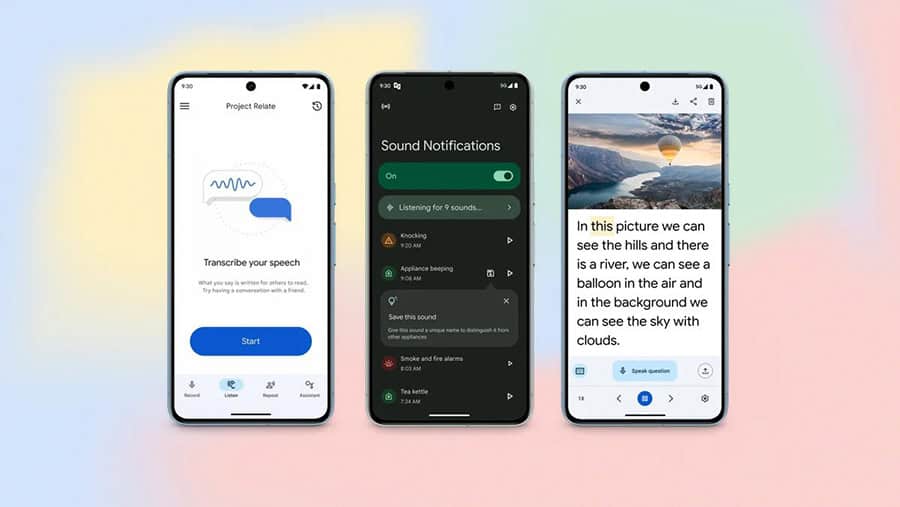
To give disabled people a better experience when using its products and services, technology giant Google has announced eight accessibility updates that it is rolling out.
Accessibility updates for Android devices
Lookout
The Lookout app on Android helps visually impaired and blind people use their phone’s camera to get more information about the world around them. Google has rolled out, in beta, Find mode, which claims to provide a new way for users to find specific objects.
Users can select from seven categories of items — like seating and tables or bathrooms — then as they move their camera around the room, Lookout notifies them of the direction and distance to the item. If the user captures a photo directly within the app, they will receive an AI-generated description of the image and learn more about the images they take.
Look to Speak
With the Android app Look to Speak, users can select pre-written, customisable phrases with their eyes and have them spoken aloud. The app has now rolled out a text-free mode.
With this mode, the user can also select and personalise emojis, symbols, and photos to activate speech. Google says this new feature is based on feedback from the community to help make communicating more accessible with cognitive differences, literacy challenges, and language barriers.
Hands-free cursor for Android Developers
Last year, Google released Project Gameface, an open-source, hands-free gaming mouse, on PC. Google’s latest update allows developers to access Project Gameface for Android devices via Github. With the help of Accessibility Service for Android and Google MediaPipe, developers can build applications that let users customise facial expressions, gesture sizes, cursor speed, and more.
Expanded accessibility features in Maps
More detailed walking instructions for users and descriptions about the world around them
For visually impaired and blind people, Google has expanded detailed voice guidance and screen reader capabilities for Lens in Maps to Android and iOS globally in all supported languages.
With screen reader capabilities for Lens in Maps, the user will hear the name and category of places around them — like cash machines and restaurants — and how far away a place is so they can quickly orient themselves and decide where to go.
When a person is walking and cannot see their phone, detailed voice guidance provides audio prompts to let them know when they are heading in the right direction, crossing a busy road, or being rerouted if they have gone the wrong way.
Enhanced accessibility updates
Maps now has accessibility information for more than 50 million places, Google underlines. The wheelchair icon in Maps indicates a place with a wheelchair-accessible entrance with more details about accessible toilets, parking, and seating under the About tab.
The wheelchair icon was previously available worldwide on Android and iOS mobile devices and is now expanding to desktop. Now, when users are viewing a place on mobile, they can filter reviews to easily find helpful information about wheelchair accessibility.
Find places that can cast to hearing devices
For those in need of hearing assistance, business owners can now add the Auracast attribute to their business profile. Auracast broadcast audio allows venues — like cinemas, gyms, and places of worship — to broadcast enhanced or assistive audio to visitors with Auracast-enabled Bluetooth hearing aids, earbuds, and headphones. Further information about adding this can be found here.
New designs for Project Relate and Sound Notifications
Customised teaching in Project Relate
In 2022, Google launched Project Relate, an Android app for people with non-standard speech, which allows users to create a personalised speech recognition model to communicate and be better understood.
Custom Cards allows users to customise the phrases it teaches the model, so it understands words that are important to them. Now, there is a new way for users to select text and import phrases from other apps as Custom Cards, like a note in a Google Doc.
New design for Sound Notifications
Sound Notifications alerts individuals when household sounds happen — like a doorbell ringing or a smoke alarm going off — with push notifications, flashes from the person’s camera light, or through phone vibrations.
Google says it has redesigned Sound Notifications based on user feedback, improving the onboarding process, sound event browsing, and making it easier to save custom sounds for appliances.
[WEB] Video: University researcher develops soft robotic arm to address lack of physiotherapy for stroke patients
Posted by Kostas Pantremenos in Paretic Hand, Rehabilitation robotics, Video on June 5, 2024
Sarah Sarsby 5th June 2024

A new assistive device could soon help people who are recovering from strokes or have a loss of mobility in the arm with their rehabilitation journey, thanks to the University of Aberdeen.
James Greig, a final year PhD researcher, has designed and built the soft robotic arm, which could allow patients to carry out physiotherapy at home in addition to existing assisted physiotherapy sessions.
The lightweight, affordable equipment uses flexible, inflatable material to support the arm as it makes basic repetitive movements, which is essential for rehabilitation following a stroke.
Physiotherapy services are stretched. Analysis from the Chartered Society of Physiotherapy (CSP) last year showed that NHS needs 12,000 more physiotherapists to expand its ability to try and meet demand.
James identified a need for technologies that patients can use safely at home to complement their regular physiotherapy.
James said: “What we’re trying to address is a product to address the lack of availability to physiotherapy for stroke patients who have maybe suffered some loss of mobility in the arm.
“I wanted to make a lightweight device that can be made readily available in the community. So it’s cheap, easy to wear and doesn’t need specialist assistance to use.
“It means people can have more physiotherapy so they can do some work at home as well as the work that they’ve been doing with the physiotherapist.”
Learn more about the rehabilitation technology in the video below:
All strokes are different depending on what part of the brain has been affected, but many people will be left with high muscle tone where the muscles develop spasticity, and the contracted muscles can leave the arm in an almost fixed pose, the University of Aberdeen says.
Typically, throughout rehabilitation, physiotherapists will try to mobilise the limb. If done from an early-stage high spasticity can be reduced.
“We’re basically trying to mimic the same movement that physios will encourage in their sessions but using robotics in a way that allows people to do this at home without the physiotherapist actually being there,” added James. “If we can augment the physio-led rehabilitation with some work they can do at home using the robotic device, then we can improve their recovery.”
The robotic device is worn on the arm, held on with straps, and works by pumping air from a small compressor into a series of strips of material which inflate, press against each other, and encourage movement in the limb – akin to a bicep curl.
While James’ innovation was designed with stroke patients in mind, it could be used to aid anyone undergoing physiotherapy on this specific movement of the arm.
“The key challenge is how we scale up these devices to generate enough force to allow them to work on larger joints without making them too heavy and too cumbersome,” explained James.
The university says that information and feedback sessions held with a group of physiotherapists saw encouraging feedback for the device.
Thérèse Lebedis, Consultant AHP (Occupational Therapist) in Stroke, who has worked with James on the project, commented: “This is an exciting development in the field of robotic technology, offering the potential to provide an adjunct to rehabilitation therapies such as occupational therapy and physiotherapy and the opportunity to increase intensity through repetition.”
A randomised clinical trial in March 2023 found that game-based rehabilitation equipment could be an effective alternative to standard care for older patients to regain their functional capacities.
[ARTICLE] Design and development of a wrist rehabilitation device with an interactive game – Full Text
Posted by Kostas Pantremenos in Paretic Hand, REHABILITATION, Video Games/Exergames on June 3, 2024
Highlights
- •Design and manufacture a wrist rehabilitation device for wrist joints that integrates with an interactive game.
- •The game interface is designed so that users can easily adjust the game parameters depending on recovery status.
- •The patient’s training effort is recorded during exercise so therapists can assess the patient’s condition.
Abstract
In this paper, a wrist rehabilitation device integrated with an interactive game is developed. The device is designed for flexion/extension and ulnar/radial motions. The motion of the wrist joint is measured by an optical encoder. A hall sensor is also used to measure the force emitted from the DC motor. These data are fed back to the interactive gaming environment to create the movement of goals in the video game. There are two types of interactive games designed. The first requires the practitioner to move their wrist to achieve a specific goal. The second exercise requires the practitioner to move their wrist joint continuously to reach moving targets. In the game interface, therapists can easily adjust training intensity, training time, and change training limits depending on the recovery status of the patients. At the same time, it also records the patient’s training efforts and monitors visual graphs of performance during exercise. The experiments were conducted to tune the games and to get a preliminary evaluation of the device. The feedback from the patients and therapists are recorded to improve the device and game interfaces. Game parameters are adjusted during the patient’s exercise process under the supervision of a physiotherapist. The values of rotation angle and torque are collected and then presented in graphs so that physiotherapists can assess the patient’s recovery status. The results show that the patients enjoy the games. The therapist is satisfied with the game interface and says that the games are intuitive and easy to play.
[…]

Fig. 4. The realistic prototype.
